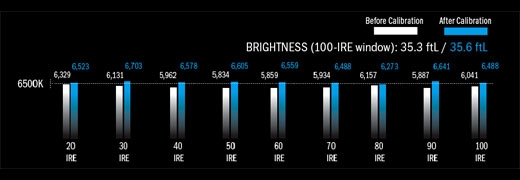Panasonic's next generation Page 3
TEST BENCH

Color temperature (THX mode/Warm color temperature Before/after calibration): 20-IRE: 6,329 K/6,523 K 30-IRE: 6,131 K/6,703 K 40-IRE: 5,962 K/6,578 K 50-IRE: 5,834 K/6,605 K 60-IRE: 5,859 K/6,559 K 70-IRE: 5,934 K/6,488 K 80-IRE: 6,157 K/6,273 K 90-IRE: 5,887 K/6,641 K 100-IRE: 6,041 K/6,488 K Brightness (100-IRE window): 35.3/35.6 ftL
Primary Color Accuracy vs. SMPTE HD Standard
| Color | Target X | Measured X | Target Y | Measured Y |
| Red | 0.64 | 0.68 | 0.33 | 0.32 |
| Green | 0.30 | 0.30 | 0.60 | 0.62 |
| Blue | 0.15 | 0.13 | 0.06 | 0.04 |
The Panasonic's THX picture preset delivered the most accurate color when its Warm color temperature preset was also selected. In that mode, grayscale tracking was +/- 641degrees K of the 6,500 K standard from 30 to 100 IRE in that mode - below average performance. Adjustments made to the color temperature controls in the set's hidden service menu improved grayscale tracking to +/-227 degrees K from 10 to 100 IRE. Color decoder tests in THX mode revealed a -15 percent red and -5 percent green error on both the HDMI and component-video inputs. As compared to the SMPTE HD specification, the set's red, green, and blue color points were notably accurate as compared to most other TVs.
Overscan - the amount of picture area hidden behind the edges of the TV's screen - measured 0% for 1080i -format high-definition signals with the Size 2 HD Size option selected. The set displayed 1080i and 720p test patterns with full resolution on the HDMI and component-video inputs, although a degree of noise was visible in the highest-frequencies of both 1080i and 720p multiburst test patterns via component video. A 480i test pattern revealed picture sharpness to be slightly below full DVD resolution level. No edge enhancement was visible via the HDMI and component-video inputs with the set's sharpness control set below its mid-point. Screen uniformity was characteristically excellent for a plasma model, with picture contrast remaining solid at all viewing angles over a near 180-degree arc.
The Panasonic passed most of the tests contained on both the Silicon Optix HQV high-def and DVD test discs with the exception of the high-def Film resolution test - one that many TVs trip up on. Its upconversion of regular DVDs look very clean and solid, if just a tad soft. The set's standard digital noise reduction setting worked well, helping to smooth out grainy images without reducing picture detail. Its MPEG noise reduction mode softened pictures when turned on, however.













































